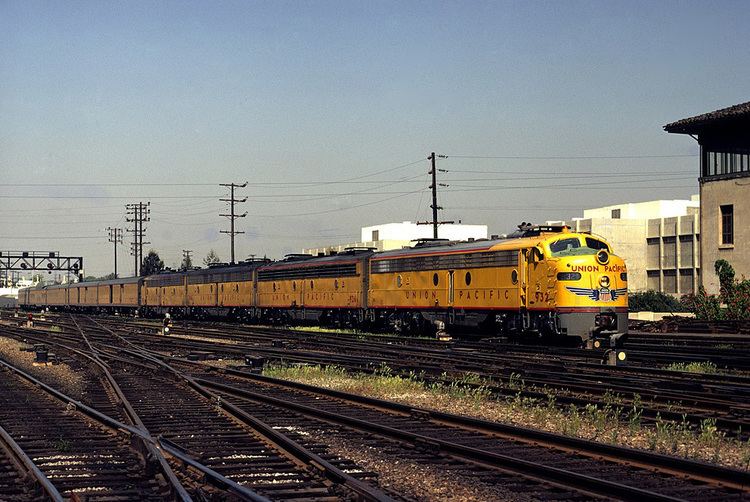 | ||
The City of Los Angeles was a streamlined passenger train between Chicago, Illinois, and Los Angeles, California via Omaha, Nebraska, and Ogden, Utah. Between Omaha and Los Angeles it ran on the Union Pacific Railroad; east of Omaha it ran on the Chicago and North Western Railway until October 1955 and on the Milwaukee Road thereafter. The train had number 103 westbound and number 104 eastbound.
Contents
- Timeline
- Other railroad uses of the name City of Los Angeles
- Equipment
- Station stops 1950
- Sample Time Tables 1947 1953
- References
This train was the top-of-the-line for UP, which marketed it as a competitor to the Super Chief, a streamlined passenger train on the Atchison, Topeka and Santa Fe Railway, and the Golden State, a streamlined passenger train jointly operated by the Rock Island and Southern Pacific railroads. As with the City of Los Angeles, many of the train's cars bore the names of locales in and around its namesake city.
CNW / UP used one of two three-unit sets of EMC E2 locomotives as motive power beginning in 1937. The UP scored a public relations coup in the mid-1950s when the City of Los Angeles was featured in two episodes of the popular television series I Love Lucy. In 1955 the Milwaukee Road assumed the service, replacing the Chicago and North Western between Chicago and Omaha. Actor Ronald Reagan often traveled on this train and even did a full page print ad for it that appeared in the National Geographic magazine. In a cost-cutting move, the City of Los Angeles was combined with the City of San Francisco in 1960.
Timeline
In 1979 Amtrak created the Desert Wind, running mostly on the City of LA route from Los Angeles to Ogden, Utah where it connected to the Oakland-Chicago train. (After a year or two some of its cars ran through to Chicago.) The Desert Wind ceased operation in 1997.
Other railroad uses of the name City of Los Angeles
The City of Los Angeles name has also been applied to a 48-seat diner built by the St. Louis Car Company in 1949. The car was originally UP No. 4808 and is currently owned and operated by the Union Pacific as part of their excursion fleet.
Equipment
The City of Los Angeles began running in 1936 using the articulated M-10002 trainset. Behind the two power units were an RPO-baggage car, a baggage-dormitory-kitchen, a diner-lounge, an 11-section sleeping car, a 7-double bedroom 2-compartment sleeper, two more 11-section sleepers, a 48-seat coach, and a 38-seat coach-buffet car. All the passenger-carrying cars were air-conditioned. The Union Pacific added a second, non-articulated train to the City of Los Angeles route in 1937. A trio of EMC E2 diesel locomotives pulled a baggage-dormitory car, two 52-seat coaches, a coffee shop-kitchen car, a dining car, a dormitory-buffet lounge, seven sleeping cars of varying configurations, and a buffet-lounge-observation car. Union Pacific added a second articulated trainset in 1938, the M-10004. Its configuration was similar to the M-10002: two power units, a baggage-dormitory, 40- and 48-seat coaches, a coffee-shop kitchen, a diner, an 11-section sleeper, two 7-double bedroom 2-compartment sleepers, two more 11-section sleepers, and a buffet-lounge-observation car.
A typical City of Los Angeles train consist around 1955 included:
Station stops, 1950
Sample Time Tables, 1947 - 1953
Notes:
Bold numbers indicate P.M.
+1 indicates the day after departure
+2 indicates two days after departure
Compare the run time to that of Amtrak's Desert Wind in 1979: Westbound (train 35) 48 hours and 30 minutes. Eastbound (train 36) 48 hours and 00 minutes.
